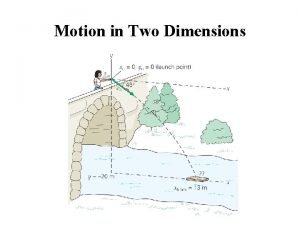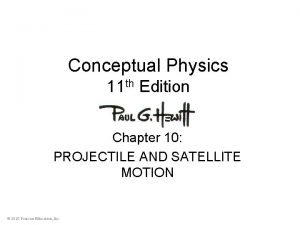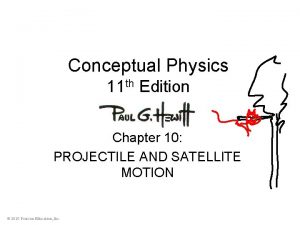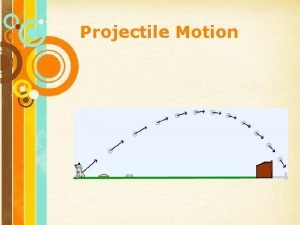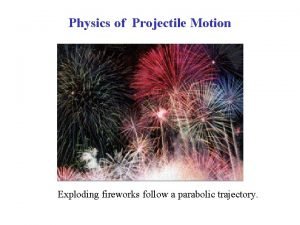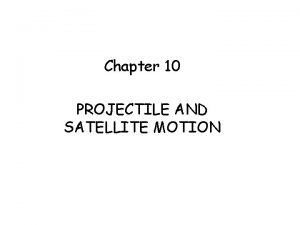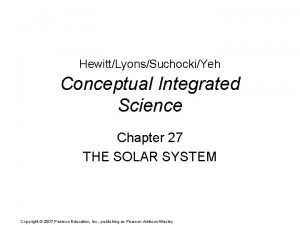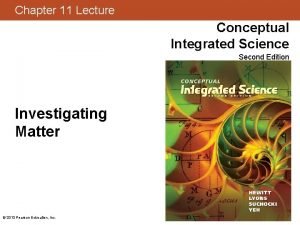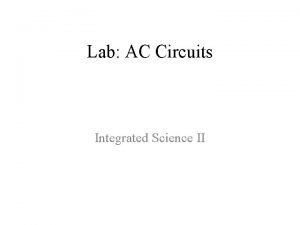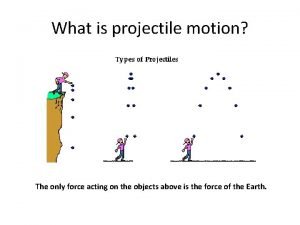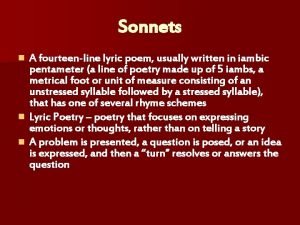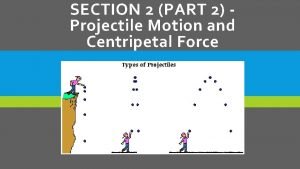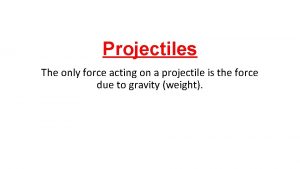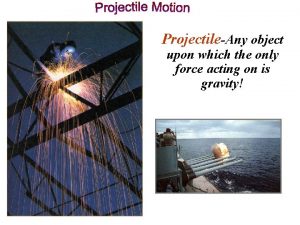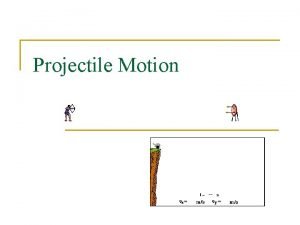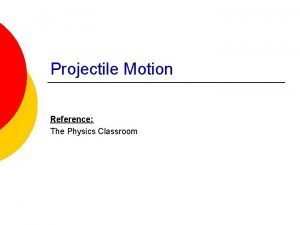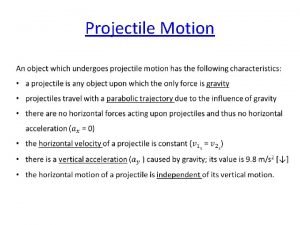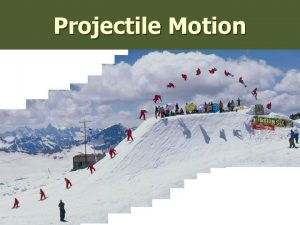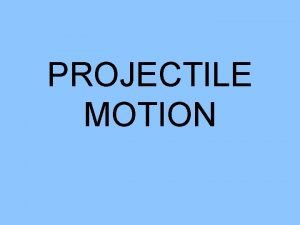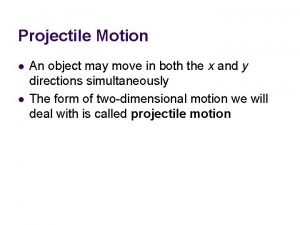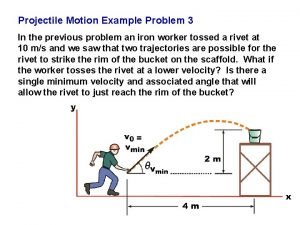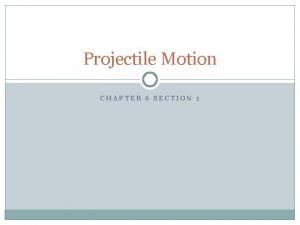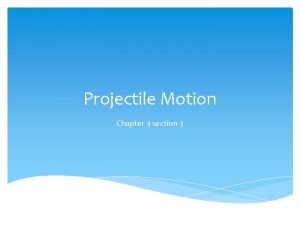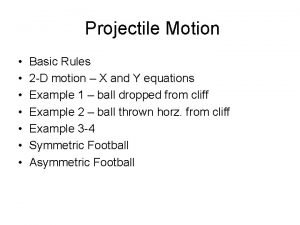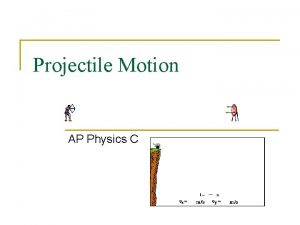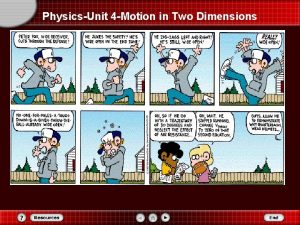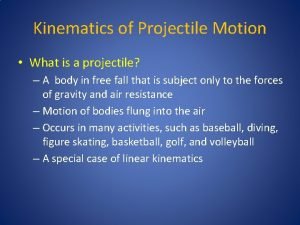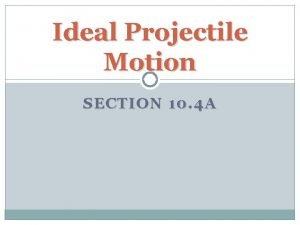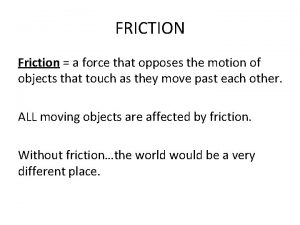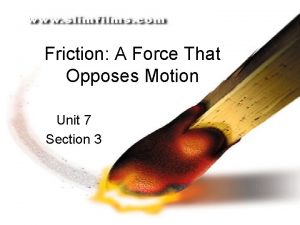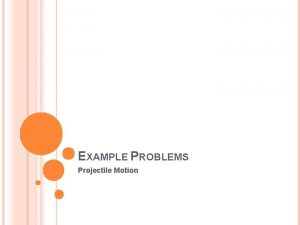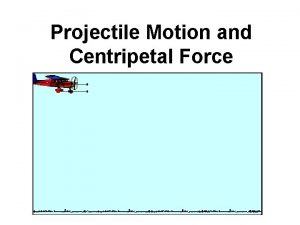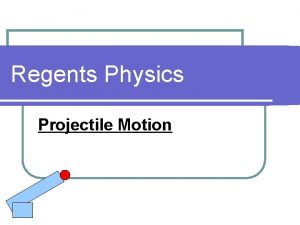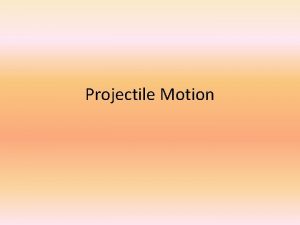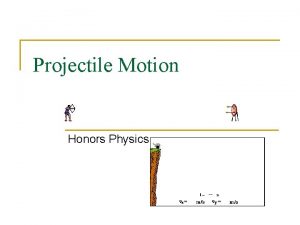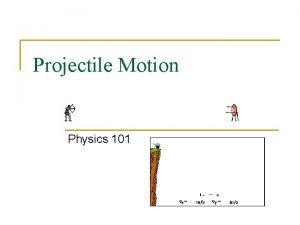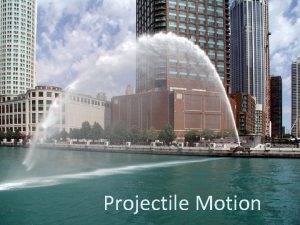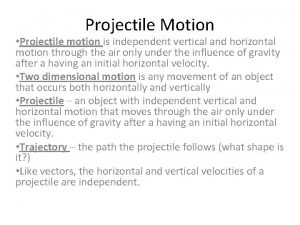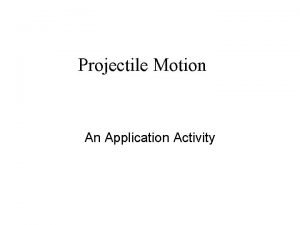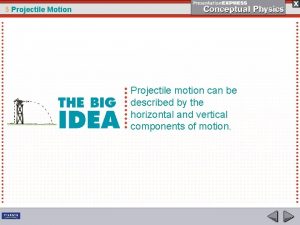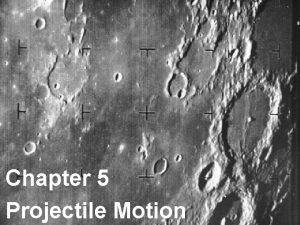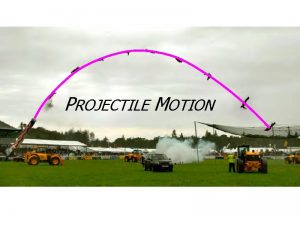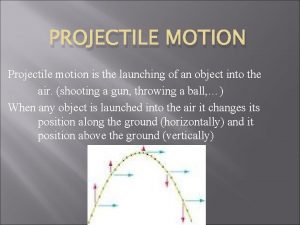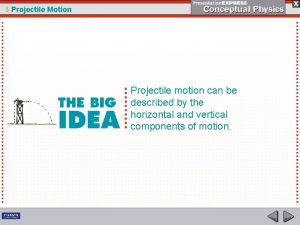Integrated Science Projectile and Satelitte Motion Projectile Motion














































- Slides: 46

Integrated Science Projectile and Satelitte Motion

Projectile Motion • Any object projected by any means that continues in motion is called a projectile. • A free falling object gains 10 m/s during each second it falls. • This acceleration is due to gravity 10 m/s 2 • If an object falls from rest it’s speed at the end of 1 second is 10 m/s. • At the end of 2 seconds the speed is 20 m/s

Projectile Motion • The falling stone gains a speed of 10 m/s each second. Fill in the speedometer readings for the times 3 & 4 seconds. • There is an error for the 2 second reading.

Projectile Motion • Although the change in speed is the same each second. The distance of fall keeps increasing for the object. • If there was no gravity and you threw a stone horizontally after each second the stone would be the same distance apart. • The reason because there is no force acting on the stone.

• There is no difference in the spacing of a object thrown horizontally (if there was no gravity). • The initial force of throwing the ball is the only force acting on the ball.

Projectile Motion • With gravity a stone falls following a curved path. • This curve is because of two kinds of motion occurring at the same time. • There is vertical motion and horizontal motion. • The curve is called a parabola.

• The vertical path (dashed line) is for a stone dropped from at rest. The horizontal path (dashed line) would occur with no gravity. The solid line shows the path that results from both the vertical and horizontal motions.


Projectile Motion A. B. Their masses are different, but the blue and green balls fall at the same rate. The yellow ball is a projectile, following a curved path.

A. Their masses are different, but the blue and green balls fall at the same rate. Why do they fall act the same rate, even though the blue and green balls have different masses?

• A stone thrown at an upward angle would follow the dashed line in the absence of gravity. Because of gravity, it falls beneath this line and describes the parabola shown by the solid curve.

• Stone thrown at a downward angle follows a somewhat different parabola.


• The velocity of the ball (light blue vector) has vertical and horizontal components. The vertical component relates to how high the ball will go. The horizontal component relates to the horizontal range of the ball.

• The horizontal and vertical components are completely independent of each other. They act as if the other didn’t exist. • The combined effects produce the curved path of projectiles.

• The velocity of a projectile at various points. Note that the vertical component changes while the horizontal component is the same everywhere. • No horizontal force exists to change the horizontal component. (assuming negligible air drag).

Concept Check 1. 2. At what part of its trajectory does a projectile have minimum speed? A tossed ball changes speed along its parabolic path. When the sun is directly overhead, does the shadow of the ball across the field also change speed? Answers on Click! 1. The minimum speed is reached at the top of its trajectory. 2. No, the shadow moves at a constant velocity due to the horizontal component of the ball velocity.

Projectile Altitude and Range We see the paths of several projectiles in the absence of air drag. All have the same initial speed, but different launch angles. Notice they reach different altitudes and some have different ranges (distance traveled horizontally)

Projectile Altitude and Range We see that the same range is obtained from angles that add to 90 o. The amount of time in the air is the only difference.

Projectile Altitude and Range • Without air drag speed lost while going up equals speed gained while coming down; time going up equals time coming down. (It takes 4 seconds to go up and 4 seconds to come down)

The effect of air drag on Projectiles • Air drag is a major factor for high speed projectiles. • The result is both range and altitude are less.

The effect of air drag on Projectiles • A baseball could be hit about 6 times the ideal range on the moon because of no air drag and gravity is 1/6 that of earth.

Satellites • If a cannon fires a cannonball so fast that its curved path matches the curvature of the earth, (without air drag) it would become a satellite. • Any satellite is simply an object that is moving fast enough to continually fall around the earth

• Throw a stone any speed and 1 second later it falls 5 meters below where it would have been if there was no gravity.

• To be a satellite the objects horizontal velocity must be great enough for its falling distance to match the curvature of the earth.

• The earth’s curvature drops a vertical distance of 5 meters for each 8000 meters tangent. (not to scale) • If you were floating in a calm ocean only be able to see a 5 m mast on ship that was 8000 meters (8 km) away. We live on a round earth.

Earth Satellites • A satellite is a projectile that is traveling fast enough that covers a horizontal distance of 8 km during 1 second. • This speed would allow it to follow the curvature of the earth. • The speed is 29, 000 km/h or 18, 000 mi/h

Earth Satellites • At these high speeds atmospheric friction would incinerate a projectile. This is what occurs with meteorites the size of sand particles, (falling stars). • This is the reason satellites like the space shuttle are launched to altitudes of 150 km to get above the atmosphere.

Earth Satellites • A common misconception is that satellites in orbit are free from gravity. The truth is that the force of gravity is nearly as great on the surface of the earth as it is 150 km above the surface. (Inverse Square Law) • If there was no gravity, motion would be a straight line, instead of curving around the earth.

Earth Satellites • High altitude puts satellites above the atmosphere but not above the pull of gravity. • The reason things appear to be “weightless” is because the shuttle and everything in it are falling at the same rate, so there is no support force.

Earth Satellites

Newton thought if a cannon was fired fast enough a cannonball would circle the earth and go into orbit.

Earth Satellites • Why don’t planets crash into the sun? • What would happen to planets if their tangential velocity were zero? • For a satellite close to the earth the time it takes to complete an orbit is about 90 minutes.

Earth Satellites • Communication satellites have altitude of 5. 5 Earth radii and have a period of 24 hours. • This means they stay above the same point on the earth. Geosynchronous orbit. • The moon is farther out its orbit period is 27. 3 days. The higher the altitude the less its speed and the longer its period.

Elliptical Orbits • If a payload above the drag of the atmosphere is given a horizontal speed somewhat greater than 8 km/s, it will overshoot a circular path and trace an elliptical orbit. • An ellipse is a specific curve. It is oval shaped which any point has the sum of distances between any two points (foci).

Elliptical Orbits • If the foci are close together the ellipse resembles more like circle. • Unlike the constant speed of a satellite in a circular orbit, speed varies in a elliptical orbit.

Elliptical Orbits • For a satellite in elliptical orbit, half the time it moves away from the earth and half the time it moves towards the earth. • When it moves away (against gravity) it slows down, when it moves towards earth (with gravity) it gains speed. • The same amount of speed lost is regained, like a stone thrown upwards.

Elliptical Orbits


Elliptical Orbits • The orbital speed of a planet varies so that a line joining the Sun and the planet will sweep over equal areas in equal time intervals. • This means that a planet moves faster closer to the Sun and slower farther away.

Escape Speed • “What goes up must come down” isn’t always true. • “What goes up may come down” is more accurate because there is a critical speed at which a projectile can outrun gravity and escape the Earth. • This speed is called escape velocity.

Escape Speed • From the surface of the earth escape velocity is 11. 2 km/s (Roughly 25, 000 mph) • Escape speed from the sun is 620 km/s (Roughly 385. 25 miles per second) • At earth’s distance from the sun to escape the sun that drops to 42. 5 km/s

Escape Speed • If a satellite is moving greater than 11. 2 km/s but slower than 42. 5 km/s it will escape Earth but not the sun and thus will take up an orbit (fall around) the sun.


Answers on Click! Several positions of a satellite in an elliptical orbit are shown. At which position does the satellite have the greatest ______? Some have Multiple Answers!!! 1. 2. 3. 4. Speed? Velocity? Mass? Gravitational attraction to the Earth? 5. 6. 7. 8. Kinetic Energy? Potential Energy? Total Energy? Acceleration (a=Force/mass)

Answers!! 1. Speed? A 2. Velocity? A 3. Mass? A, B, C, D Answers on Click! 4. Gravitational attraction to the Earth? A 5. Kinetic Energy? A 6. Potential Energy? C 7. Total Energy? A, B, C, D 8. Acceleration (a=Force/mass) A Several positions of a satellite in an elliptical orbit are shown. At which position does the satellite have the greatest ______? Some have Multiple Answers!!! 1. 2. 3. 4. Speed? Velocity? Mass? Gravitational attraction to the Earth? 5. 6. 7. 8. Kinetic Energy? Potential Energy? Total Energy? Acceleration (a=Force/mass)
 My favorite subject is music
My favorite subject is music How to calculate horizontal displacement
How to calculate horizontal displacement Chapter 10 projectile and satellite motion tossed ball
Chapter 10 projectile and satellite motion tossed ball Chapter 10 projectile and satellite motion tossed ball
Chapter 10 projectile and satellite motion tossed ball Projectile motion ppt free download
Projectile motion ppt free download Porjectile motion
Porjectile motion Chapter 10 projectile and satellite motion tossed ball
Chapter 10 projectile and satellite motion tossed ball What is matter in integrated science
What is matter in integrated science Lone star nursing requirements
Lone star nursing requirements Conceptual integrated science explorations
Conceptual integrated science explorations Conceptual integrated science
Conceptual integrated science Integrated science labs
Integrated science labs High school 101 class
High school 101 class Only force acting on the projectile is
Only force acting on the projectile is Symmetrical projectile motion
Symmetrical projectile motion How are uniform circular motion maps
How are uniform circular motion maps Fourteen line lyric poem
Fourteen line lyric poem An object in projectile motion will follow which path?
An object in projectile motion will follow which path? The only force acting on projectile is
The only force acting on projectile is What is the only force that acts upon projectiles?
What is the only force that acts upon projectiles? What is projectile
What is projectile Hewitt
Hewitt Projectile motion in everyday life
Projectile motion in everyday life Projectile motion simulator
Projectile motion simulator Which describes an object in projectile motion?
Which describes an object in projectile motion? Motion of a projectile
Motion of a projectile Tennis ball projectile motion
Tennis ball projectile motion Examples of projectile motion in volleyball
Examples of projectile motion in volleyball Range formula physics
Range formula physics Maximum height
Maximum height A projectile has a single force that acts upon it
A projectile has a single force that acts upon it Examples of projectile motion
Examples of projectile motion Symmetrical projectile motion
Symmetrical projectile motion Is projectile
Is projectile Projectile motion objectives
Projectile motion objectives Projectile motion equations
Projectile motion equations Ap physics
Ap physics Formula for time of flight in projectile motion
Formula for time of flight in projectile motion Physics motion
Physics motion Objects that exhibit projectile motion follow a path.
Objects that exhibit projectile motion follow a path. Ballistic device
Ballistic device Horizontal displacement of a projectile
Horizontal displacement of a projectile Time of flight of projectile formula
Time of flight of projectile formula A force that opposes motion of a projectile
A force that opposes motion of a projectile A force that opposes motion of a projectile
A force that opposes motion of a projectile What is a factor that affects the flight of a projectile
What is a factor that affects the flight of a projectile Projectile motion example problems
Projectile motion example problems

